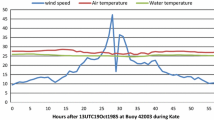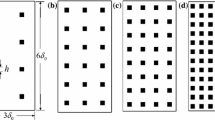Abstract
Calculations are made of the effects of thermal stability under a range of conditions, over the sea and land, on the physical factors (including the critical wind speed) affecting dust-storm generation, snow drift, and rough sea conditions. The computational procedure involves the surface friction velocity, u *, and its relation with the aerodynamic roughness over aerodynamically rough, mobile surfaces. The results indicated that even at relatively high wind speeds, thermal effects under extreme advection situations may be significant, particularly for those properties of the agitated surface dependent on u * 3 and u * 4.
Similar content being viewed by others
References
Bagnold, R. A.: 1941, The Physics of Blown Sand and Desert Dunes. Methuen, London, 265 pp.
Brutsaert, W.: 1982, Evaporation into the Atmosphere. D. Reidel Pub. Co., Dordrecht, Holland, 299 pp.
Chamberlain, A. C.: 1983, ‘Roughness Length of Sea, Sand and Snow’, Boundary-Layer Meteorol. 25, 405–409.
Charnock, H.: 1955, ‘Wind Stress on a Water Surface’, Quart. J. Roy. Meteor. Soc. 81, 639–640.
Chepil, W. S.: 1951, ‘Properties of Soil which Influence Wind Erosion, 4, State of Dry Aggregate Structure’. Soil Sci. 72, 387–401.
Francey, R. J. and Garratt, J. R.: 1978, ‘Eddy Flux Measurements Over the Ocean and Related Transfer Coefficient’, Boundary-Layer Meteorol. 14, 153–166.
Garratt, J. R. and Ryan, B. F.: 1989, ‘The Structure of the Stably Stratified Internal Boundary Layer in Offshore Flow Over the Sea’, Boundary-Layer Meteorol. 47, 17–40.
Gillette, D. A., Adams, J., Endo, A., and Smith, D.: 1980, ‘Threshold Velocities for Input of Soil Particles into Air by Desert Soil’, J. Geophys. Res. 85, 5621–5630.
Gillette, D. A. and Passi, R.: 1988, ‘Modeling Dust Emission Caused by Wind Erosion’. J. Geophys. Res. 96, 14233–14242.
Kind, R. J.: 1981, ‘Snow Drifting’, in D. M. Gray and D. H. Male (eds.) Handbook of Snow, Pergamon Press, pp. 338–359.
Lettau, K. and Lettau, H. H.: 1978, ‘Experimental and Micrometeorological Field Studies of Dune Migration’, in H. H. Lettau and K. Lettau (eds.) Exploring the World's Driest Climate, Center for Climatic Research, Institute for Environmental Studies, University of Winsconsin-Madison, pp. 110–147.
Melville, W. K.: 1977, ‘Wind Stress and Roughness Length Over Breaking Waves’, J. Physic. Ocean 7, 702–710.
Segal, M. and Pielke, R. A.: 1988, ‘The Extrapolation of Vertical Profiles of Wind Speed Within the Marine Atmosphere Surface Layer Using the p Formula’, J. App. Meteorol. 17, 174–181.
Tabler, R. D.: 1980, ‘Self-Similarity of Wind Profiles in Blowing Snow Allows Outdoor Modeling’, J. Glaciol. 26, 421–434.
Wu, J.: 1980, ‘Wind-Stress Coefficients Over Sea Surface Near Neutral Conditions — A Revisit’, J. Phys. Oceanogr. 10, 727–740.
Author information
Authors and Affiliations
Rights and permissions
About this article
Cite this article
Segal, M. On the impact of thermal stability on some rough flow effects over mobile surfaces. Boundary-Layer Meteorol 52, 193–198 (1990). https://doi.org/10.1007/BF00123184
Revised:
Issue Date:
DOI: https://doi.org/10.1007/BF00123184




